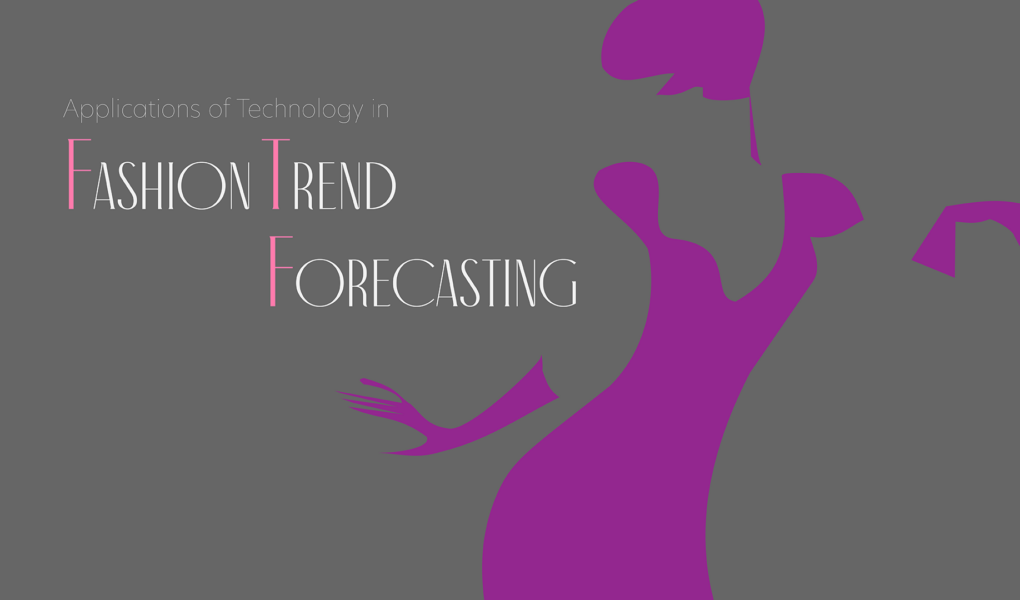Each season, we see new fashion trends emerge. Recently in women’s fashion, we’ve seen bright bags, mini skirts, and low-rise pants return to the spotlight. These items were also in style in the 90s and early 2000s but were deemed gauche by the late 2000s. Who, or what, decides these changes in popularity? Multiple factors go into the popularization of a style; these can range from pop-cultural to environmental to economic factors. For example, moto jackets in the 1950s became increasingly popular because of the movie The Wild One, where Marlon Brando wore the iconic leather jacket (Courcey, 2021). How fashion trends change over time can be seen and predicted using fashion trend forecasting and prediction models for different categories of fashion. There are two types of trends considered in fashion trend forecasting models: micro-trends, which last from a few months to a year, and macro-trends, which last longer and are due to shifts in lifestyle and societal functions. Fashion trend forecasting through data analytics saves businesses a significant amount of time that they would otherwise spend collecting and collating local and worldwide information. As artificial intelligence becomes increasingly available, many fashion brands and companies are using this technology for trend forecasting. Artificial intelligence combined with past data analytics tools has the potential to revolutionize the fashion industry by allowing companies to create predictions faster and more accurately.
Before computers, fashion trends were predicted on the macro level and were heavily based on cultural and environmental factors. In the 1970s, this culture was established by major fashion designers such as Karl Lagerfeld and celebrities like Joni Mitchell. Mitchell was known for her signature look of tie-dye blouses, volumized hair, and kaftans, which set the trend of bohemian style in the 70s . Due to the lack of technology and data analysis tools, fashion houses were left to observe and analyze the looks of style icons to determine which trends and styles they should sell to consumers. Micro-trend forecasting was rarely used because trends would disappear in a matter of months and were not worth the risk and investment for companies and brands. However, in the 2010s, there was a significant boom in micro-trends in fashion. The major reason behind this was the increase in data analysis tools and their new applications in the fashion industry.
Data analysis tools provide quick and creative insight through extensive study and analysis. Because of their fast analytical capabilities, these tools can promote the financial success of micro-trends. For example, a company wishing to create a new trend can forecast a demographic’s reaction to it by looking at how the demographic reacted to similar products in the past. The company could then target that age group with marketing strategies. Business data analysts use three main types of analysis in the fashion industry: descriptive analytics, predictive analytics, and prescriptive analytics. Descriptive analytics allows us to summarize past data and observe previous trends, predictive analytics allows trend forecasters to use historical data to predict future trends, and finally, prescriptive analytics helps to guide future decisions (University of Bath, 2021). By using tools such as data modeling, seasonality, and linear regression models, data analysts can collect past data and predict future trends, the length of the trends, and their popularity. These tools also allow companies to target desired consumer markets.
A luxury fashion company, such as Hermès, has a significantly different consumer base than a fast-fashion company, such as Fashion Nova. Luxury brands tend to focus on macro-trends and pull previous years’ sales data from their brand and other similar brands to analyze the longevity of their products. On the other hand, fast fashion companies focus on micro-trends and their popularity. They may pull qualitative consumer data regarding certain items or look to influencers to forecast which pieces will sell. Luxury brands tend to focus on classic styles while fast fashion brands tend to focus on short-lived but mass-produced items. Both types of trends fluctuate over time, with the main difference being the length of time a trend is in popularity. Because both types of trends exhibit similar behavior (apart from total time in style), similar data analysis tools can be applied to both.
To understand the process of data analytics in trend forecasting, we can inspect the modeling of trends with seasonality. Suppose that the following data indicates the demand for a particular shoe style (This data set and model are quoted from a lecture by Professor Geza Bottlik at the University of Southern California):

Figure 1: Demand for a Shoe Style Over Time (G. Bottlik, 2022)
The data column describes the relative demand for the shoe style in each time period. Note that months 17-20 will be forecasted through a seasonal model. We see that the data is seasonal, assales increase and decrease along a cycle. This data set, in particular, indicates low sales in quarter 2 and high sales in quarter 4, with a general upward trend. Next, we take the given data for demand and remove the seasonal patterns. This creates deseasonalized data which is useful in exploring trends. By “de-seasoning” the data and creating a trend line that describes demand more linearly, we establish that there is an upward trend in sales and can forecast future sales based on the upward trend. When graphed, the forecast along with the data is shown below:

Figure 2: Trend Forecasting of a Shoe Style (G. Bottlik, 2022)
As shown, this trend is on an upward trajectory and the company can now plan to produce more of this particular shoe style to satisfy the anticipated demand. This example shows how easy it is to understand the longevity of a trend. Note that the trend likely won’t continue to increase in popularity forever. If new data shows that sales are reducing, it would likely indicate a downward shift in the trend, and the forecast would adjust to show reduced future sales. This tool can be utilized to establish long-lasting trends, which is often done by luxury fashion companies.
Similar to data analytics, artificial intelligence (AI) is now transforming trend forecasting. AI uses algorithms to predict and forecast trends based on data such as consumer behavior, runway looks, and common themes (i.e. color, texture, and material); however, AI allows models to run quicker. Before the emergence of artificial intelligence and data analytics, designers and style editors traveled to stores, warehouses, and fashion shows to understand and analyze the current trends. Artificial intelligence technology allows brands to skip this step and focus on production and innovation. Unlike the data model shown above, artificial intelligence can “learn” based on new data and can account for environmental factors like material shortages. For example, AI technology can analyze a runway show of a company’s competitors to determine ways to challenge the competition and come up with new ideas that are backed by statistical data. One strategy that uses AI in trend forecasting is an audience intelligence tool. This tool allows companies to understand who their target audience is by running a search algorithm through data that showcases the similarities between customers. Then, the tool can analyze the data to forecast consumer opinion and favorability toward a particular style or trend (D. Wilkins, 1969). By understanding their target audience, a company can create suitable advertisements and other marketing strategies. For example, if the target audience is Gen-Z women, the company may use influencer marketing to reach the consumer.
When using artificial intelligence in trend forecasting, companies have a responsibility to prevent the increase of microtrends. If artificial intelligence is used irresponsibly in fashion, it can be used to predict micro-trends, and companies could sell fast-fashion items and/or pieces that will be out of style in a short period. Because microtrends disappear within a few months to a year they contribute to a great amount of textile waste and environmental damage. In fact, in under 20 years, the amount of clothes discarded by US consumers has increased from 7 million to 14 million tons. Additionally, in the last 15 years, the average customer purchased 60% more clothing. Each item is now preserved for half the time it used to be (Wrap Compliance, 2021). The environment and e-commerce are two important variables that influence consumer behavior patterns. As a result, if companies want to maintain an edge in the retail fashion industry, they must adapt to create environmentally sustainable solutions for their products; one potential solution is to stop promoting fast fashion and microtrends and utilize the power of artificial intelligence and trend forecasting to strategically promote long-lasting clothing items. As artificial intelligence enters an era of exponential development, its potential must be harnessed to give solutions for sustainability and the utilization of waste and renewable resources. One potential solution for sustainability issues is to employ the aforementioned audience intelligence tool. In doing so, a company can forecast the longevity of consumer opinion regarding the product. Ultimately, the main reason why longer-lasting trends are not prioritized is profit. Short-term clothing items do not have to be good quality and are cheaper to produce; however, the implications of clothing waste on our planet should be reason enough to prioritize long-lasting trends.
As artificial intelligence transforms the way trends are forecasted, it will undoubtedly change the fashion industry, similar to how data analysis tools transformed fashion forecasting in the 2010s. It is capable of increasing the emergence of fast fashion if used unethically as AI can predict new trends more quickly than past data analytics tools. However, AI also is capable of really great things such as ensuring that a brand’s values and style are aligned with its target customer base and more accurately predicting the longevity of a style for a brand’s customer base. Because of this, companies and brands have the responsibility to use AI for purposeful innovation such as researching biodegradable materials, macro trends, and prioritizing trends with longevity. By doing so, consumers and companies can limit textile waste and work towards a more sustainable future.
Bibliography
Leaper 06/01/2021 2:00 pm and C. Leaper, “70s fashion: The moments that defined seventies style,” Marie Claire, 06-Jan-2021. [Online]. Available: https://www.marieclaire.co.uk/fashion/1970s-fashion-moments-that-defined-seventies-style-96107. [Accessed: 17-Jan-2022].
Wilkins, J. Magalit, N. Austin, K. Karruli, and E. Khalid, “Fashion trend forecasting with AI,” TUC, 31-Dec-1969. [Online]. Available: https://www.tucmag.net/fashion/fashion-trend-forecasting-with-ai/#:~:text=The%20process%20of%20trend%20predicting,features%20like%20age%20or%20location. [Accessed: 18-Jan-2022].
Bottlik, “Seasonality and Forecasting,” in ISE 410: Planning and Scheduling, 13-Jan-2022.
“How brands can harness data analytics for fashion,” Heuritech, 12-Nov-2021. [Online]. Available: https://www.heuritech.com/articles/fashion-solutions/data-analytics-for-fashion/. [Accessed: 18-Jan-2022].
Brownlee, “How to identify and remove seasonality from time series data with python,” Machine Learning Mastery, 14-Aug-2020. [Online]. Available: https://machinelearningmastery.com/time-series-seasonality-with-python/. [Accessed: 18-Jan-2022].
MasterClass, “Fashion trend forecasting: How brands predict new styles – 2022,” MasterClass, 08-Nov-2020. [Online]. Available: https://www.masterclass.com/articles/fashion-trend-forecasting-guide#5-ways-fashion-brands-forecast-trends. [Accessed: 18-Jan-2022].
“Seasonality,” 6.4.4.3. Seasonality. [Online]. Available: https://www.itl.nist.gov/div898/handbook/pmc/section4/pmc443.htm. [Accessed: 18-Jan-2022].
Courcey, “The history of the motorcycle jacket,” Ape to Gentleman, 21-Oct-2021. [Online]. Available: https://www.apetogentleman.com/motorcycle-jacket-history/. [Accessed: 18-Jan-2022].
University of Bath, “Descriptive, predictive and prescriptive: Three types of Business Analytics,” The University of Bath, 22-Oct-2021. [Online]. Available: https://online.bath.ac.uk/content/descriptive-predictive-and-prescriptive-three-types-business-analytics. [Accessed: 18-Jan-2022].
Wrap Compliance, Ed., “Micro-trends: The acceleration of fashion cycles and rise in waste,” WRAP, 17-May-2021. [Online]. Available: https://wrapcompliance.org/blog/micro-trends-the-acceleration-of-fashion-cycles-and-rise-in-waste/. [Accessed: 18-Jan-2022].



